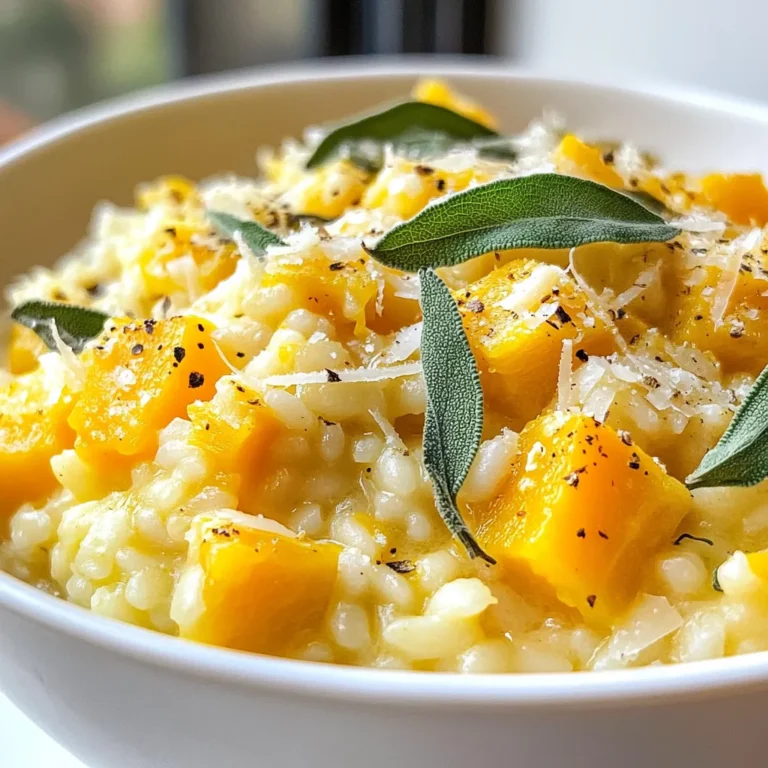Looking for a cozy meal that’s both creamy and flavorful? Butternut squash risotto is the answer! This dish combines sweet squash with rich, hearty rice. I’ll guide you through each step, from picking the best squash to achieving that dreamy texture. Got dietary needs? No worries! You’ll find tips to make it vegan or gluten-free. Ready to dive in? Let’s create a comforting bowl of risotto together!
Why I Love This Recipe
- Comforting Flavor: This risotto combines the sweet, nutty taste of butternut squash with creamy Arborio rice, creating a comforting dish that’s perfect for fall.
- Easy to Make: With simple ingredients and straightforward steps, this recipe is approachable for both novice and experienced cooks.
- Customizable: You can easily adjust the recipe by adding your favorite herbs, spices, or vegetables to suit your taste or dietary preferences.
- Impressive Presentation: Serve it with fresh sage and a drizzle of olive oil for a dish that looks as good as it tastes, making it perfect for entertaining.
Ingredients
Complete List of Ingredients
To make a tasty butternut squash risotto, gather the following:
- 1 medium butternut squash, peeled and diced
- 1 cup Arborio rice
- 4 cups vegetable broth
- 1 medium onion, finely chopped
- 2 cloves garlic, minced
- 1/2 cup Parmesan cheese, grated (or nutritional yeast for a vegan option)
- 2 tablespoons olive oil
- 1 tablespoon butter (or vegan butter)
- Salt and pepper to taste
- Fresh sage leaves, for garnish
Tips for Selecting Butternut Squash
When you choose your butternut squash, look for these signs:
- It should feel heavy for its size.
- The skin should be firm and smooth.
- Choose one with a rich, tan color.
- Avoid any squash with soft spots or blemishes.
These tips help you find the best squash for your risotto. Fresh squash adds great flavor and texture.
Alternatives for Dietary Restrictions
If you have dietary needs, here are some helpful swaps:
- For a vegan option, use nutritional yeast instead of Parmesan cheese.
- To keep it gluten-free, ensure your vegetable broth is certified gluten-free.
- Replace butter with vegan butter for a dairy-free version.
These options let everyone enjoy this creamy dish without worry.

Step-by-Step Instructions
Preparing the Vegetable Broth
Start by heating 4 cups of vegetable broth in a medium pot. Bring it to a gentle simmer over low heat. This step keeps the broth warm, which is key for the risotto. If the broth is cold, it can slow down the cooking process and make the rice tough.
Sautéing the Aromatics
In a large skillet, heat 2 tablespoons of olive oil and 1 tablespoon of butter over medium heat. Add 1 finely chopped onion and sauté it for about 5 minutes. The onion should become soft and clear. Next, stir in 2 minced garlic cloves and 1 medium butternut squash, diced. Cook these for 5 to 7 minutes. You want the squash to start to soften but not turn mushy. This mix adds deep flavor to the dish.
Cooking the Risotto to Perfection
Now it’s time for the rice! Add 1 cup of Arborio rice to the skillet. Stir it for 1 to 2 minutes. This toasting step gives the rice a nutty taste. Begin adding the warm vegetable broth one ladle at a time. Stir constantly as the rice absorbs the liquid. Wait until the rice drinks up most of the broth before adding more. Keep this up for about 18 to 20 minutes. The risotto should become creamy and al dente. Once it’s just right, take it off the heat and stir in 1/2 cup of grated Parmesan cheese. Season with salt and pepper to taste. Let the risotto sit for a couple of minutes before serving.
Tips & Tricks
Achieving the Creamy Texture
To make your butternut squash risotto creamy, you need to stir often. This helps release the starch from the Arborio rice. Starch makes risotto rich and smooth. Start by adding warm broth one ladle at a time. Wait until the rice absorbs most of the liquid before adding more. This method takes time but gives great results. Keep stirring, and soon you’ll have a creamy dish that delights everyone.
Cooking Tips for Beginners
If you are new to cooking risotto, don’t worry! Start with simple steps. Use a large skillet for better heat control. Heat the olive oil and butter first. Sauté the onion until it’s soft. Then add the garlic and butternut squash. This builds the base flavor. Remember to taste as you cook. Adjust the salt and pepper to your liking. Patience is key. It may take 18-20 minutes, but the creamy texture is worth it.
Best Types of Rice for Risotto
Choosing the right rice is vital for risotto. Arborio rice is the most common choice. It has a high starch content, making it perfect for creamy dishes. Other good options include Carnaroli and Vialone Nano. They also create that rich texture. Avoid using long-grain rice. It won’t give you the same creamy result. Stick with Arborio for the best butternut squash risotto!
Pro Tips
- Use Fresh Ingredients: Opt for fresh butternut squash and high-quality vegetable broth to enhance the flavor of your risotto.
- Stir Constantly: Consistent stirring helps release the starches from the Arborio rice, resulting in a creamy texture.
- Adjust Consistency: If you prefer a creamier risotto, add a splash of white wine or more broth towards the end of cooking.
- Garnish Wisely: Fresh sage leaves provide a wonderful aroma and flavor; consider toasting them lightly for an added depth of taste.

Variations
Vegan and Dairy-Free Options
You can make a vegan butternut squash risotto by using nutritional yeast instead of cheese. This gives a cheesy flavor without dairy. You can also swap butter with vegan butter. Use vegetable broth to keep it plant-based. This way, everyone can enjoy a creamy dish.
Adding Additional Proteins or Vegetables
Want to add some protein? Try adding cooked chickpeas or lentils. This boosts the dish’s nutrition. You can also mix in veggies like spinach or kale. They add color and taste. Just stir them in during the last few minutes of cooking.
Flavor Twists (e.g., adding herbs or spices)
Herbs and spices can change the flavor of your risotto. Try adding a pinch of nutmeg for warmth. Fresh herbs like thyme or rosemary add a nice touch too. For a kick, toss in some red pepper flakes. Each twist gives a new taste to this classic dish.
Storage Info
How to Store Leftover Risotto
To keep your leftover risotto fresh, you should store it in an airtight container. Make sure to let it cool down first. This helps prevent moisture build-up, which can make the risotto soggy. Place the container in the fridge. It will stay good for about three days.
Reheating Tips for Creaminess
When reheating your risotto, you want to keep that creamy texture. Use a saucepan on low heat. Add a splash of vegetable broth or water to help loosen it up. Stir it often to ensure even heating. This will help bring back its creamy goodness. If it gets too thick, just add more liquid.
Freezing Risotto for Future Meals
If you want to save risotto for later, freezing is a great option. Place the cooled risotto in a freezer-safe container. Make sure to leave some space at the top for expansion. It can last up to three months in the freezer. When you’re ready to eat, thaw it in the fridge overnight before reheating.
FAQs
What is the best type of rice for risotto?
The best rice for risotto is Arborio rice. This rice has a high starch content. It gives risotto its creamy texture. You can also use Carnaroli or Vialone Nano for a similar effect. These rice types absorb liquid well. They also release starch, which thickens the dish.
Can I make risotto in advance?
Yes, you can make risotto in advance. However, it is best to serve it fresh. If you do make it early, store it in the fridge. Keep it in an airtight container. When you reheat it, add a bit of broth. This keeps the risotto creamy and delicious.
How long can I store butternut squash risotto in the fridge?
Butternut squash risotto can be stored in the fridge for 3 to 5 days. Make sure it is in a sealed container. If you notice any off smell, it’s best to discard it. Always check for freshness before eating leftovers.
You learned how to make delicious butternut squash risotto. We covered the key ingredients, tips for selection, and dietary options. Step-by-step, you can prepare rich broth and sauté aromatics. You now know how to achieve creamy texture and choose the best rice. We explored fun variations and proper storage.
With these skills, you can create a tasty meal any time. Enjoy your cooking and experiment with flavor

Butternut Bliss Risotto
Ingredients
- 1 medium butternut squash, peeled and diced
- 1 cup Arborio rice
- 4 cups vegetable broth
- 1 medium onion, finely chopped
- 2 cloves garlic, minced
- 0.5 cup Parmesan cheese, grated (or nutritional yeast for a vegan option)
- 2 tablespoons olive oil
- 1 tablespoon butter (or vegan butter)
- to taste salt and pepper
- for garnish fresh sage leaves
Instructions
- In a medium pot, bring vegetable broth to a gentle simmer over low heat.
- In a large skillet, heat olive oil and butter over medium heat. Add the chopped onion and sauté until translucent, about 5 minutes.
- Stir in the minced garlic and diced butternut squash. Cook for an additional 5-7 minutes until the squash begins to soften.
- Add the Arborio rice to the skillet, stirring for 1-2 minutes until the grains are lightly toasted.
- Begin adding the warm vegetable broth one ladle at a time, stirring constantly. Allow the rice to absorb most of the liquid before adding more broth. Repeat this process until the rice is creamy and al dente, about 18-20 minutes total.
- Once the risotto reaches your desired consistency, remove it from the heat and stir in the grated Parmesan cheese (or nutritional yeast). Season with salt and pepper to taste.
- Let the risotto rest for a couple of minutes before serving.


